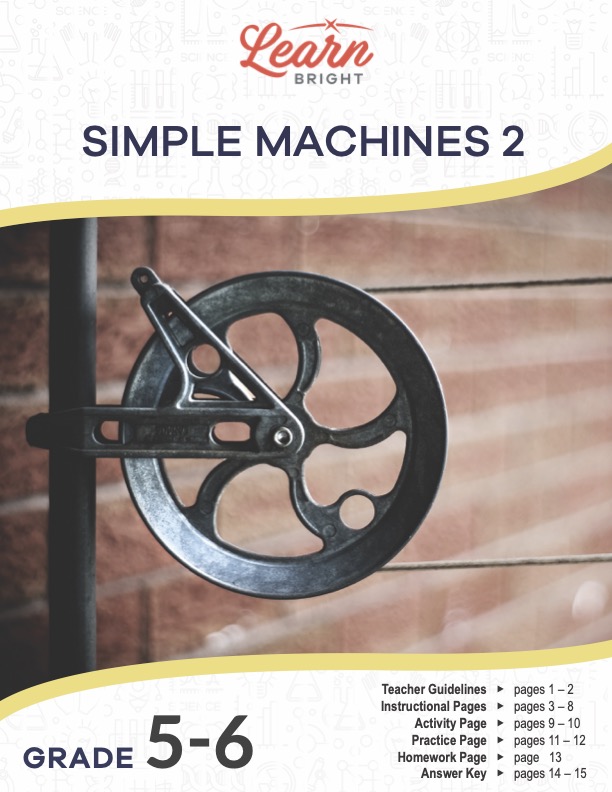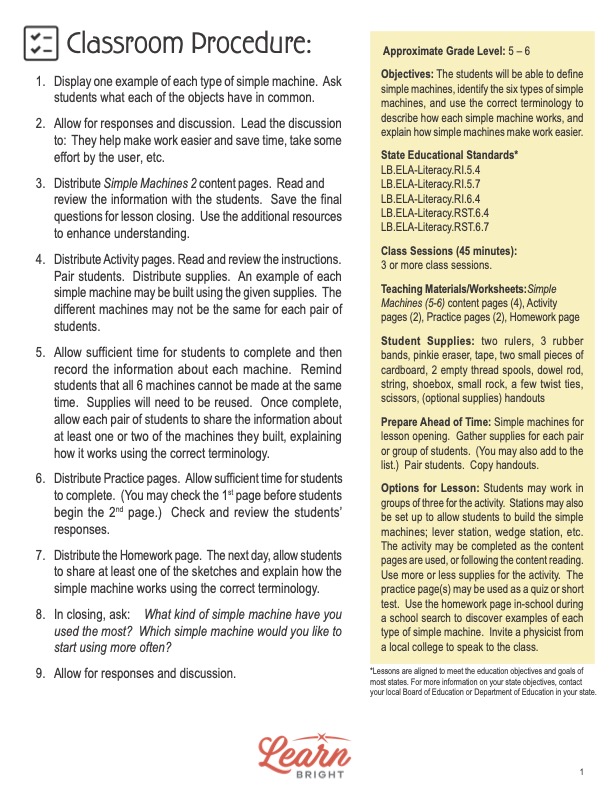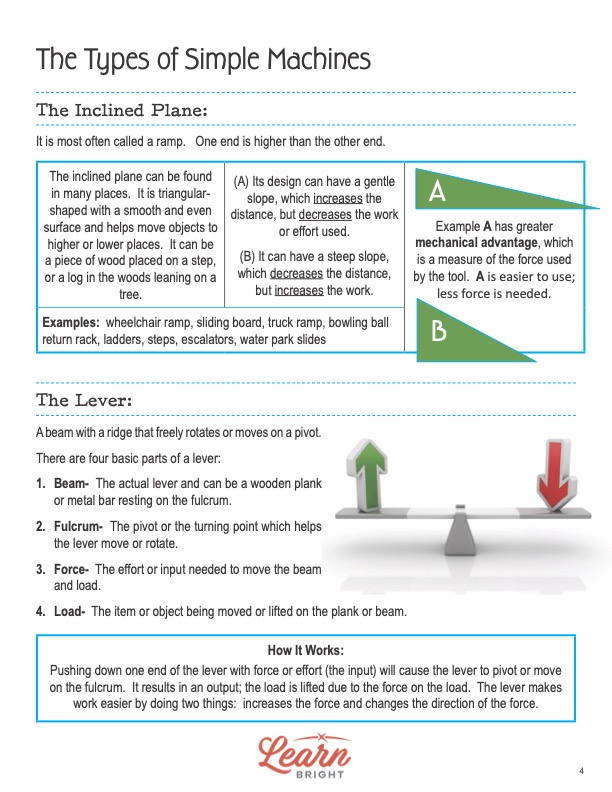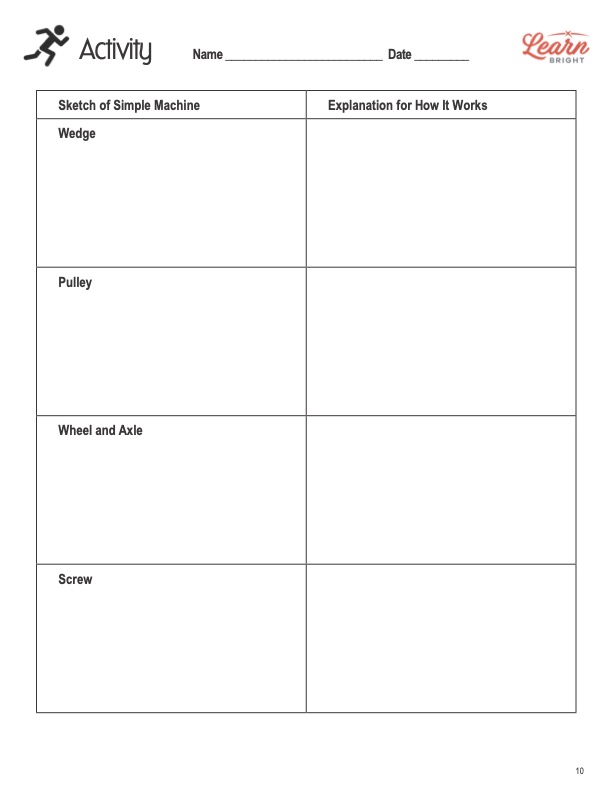Description
What our Simple Machines 2 lesson plan includes
Lesson Objectives and Overview: Simple Machines 2 explores what a simple machine is and how it can make certain tasks easier. Students will discover the six different types and will be able to identify and name them. They will learn about the inclined plane, edge, screw, lever, wheel and axel, and pulley. This lesson is for students in 5th grade and 6th grade.
Classroom Procedure
Every lesson plan provides you with a classroom procedure page that outlines a step-by-step guide to follow. You do not have to follow the guide exactly. The guide helps you organize the lesson and details when to hand out worksheets. It also lists information in the yellow box that you might find useful. You will find the lesson objectives, state standards, and number of class sessions the lesson should take to complete in this area. In addition, it describes the supplies you will need as well as what and how you need to prepare beforehand. This lesson requires a fair number of supplies, including rulers, rubber bands, empty thread spools, twist ties, and scissors.
Options for Lesson
In the “Options for Lesson” section, you can find several suggestions for additional activities to take advantage of during the lesson. One suggestion is to divide the supplies among different stations for students to go to for the activity. This would allow students to get creative as they work with different supplies to create each simple machine. You can also add whatever extra supplies you wish. Another option is to use the practice worksheet as a quiz or short test and the homework page as an in-class activity. You could explore around or outside the school to find examples of different types of simple machines. One other option is to invite a physicist to come speak to the class and share their expertise.
Teacher Notes
The paragraph on the teacher notes page provides a little extra information and guidance for this lesson. It mentions that this lesson expands on the material from our Simple Machines 1 lesson. It contains more hands-on activities to help students better understand the subject matter. The blanks lines on this page give you space to add any notes you have before presenting the lesson to your students.
SIMPLE MACHINES 2 LESSON PLAN CONTENT PAGES
What Simple Machines Are and How They Work
This lesson contains six pages of content. Students will first learn how to define what a machine actually is. They will discover that the purpose of these tools is to make work easier to accomplish and to save time. In addition, they will recognize that a machine either increases force or increases the distance of the force, but cannot do both at the same time. The lesson explains this concept through the example of a dump truck. A small dump truck can carry a few tons of soil quickly from one place to another. A large dump truck can carry much more soil, but it will take longer.
Students will then learn that complex machines like dump trucks are just a combination of simple machines. A simple machine is a tool with very few moving parts that help people work more easily. They allow people to use less energy when working. Some things take more energy, which means they require more work, and vice versa. Students will understand that a great number of things they use every day are actually simple machines, even a toothpick!
Types of Simple Machines
Students will then learn in detail about the six types of machines that help make work easier. The lesson outlines each machine by providing a description and a few examples over the course of the remaining five pages.
Inclined Plane, Lever, and Wedge
Inclined plane: Students will recognize that this tool looks a lot like a ramp, which is indeed another term to describe this tool. Generally speaking, these have smooth and even surfaces so that people can easily move objects to higher or lower places. The lesson shows two examples, one with a gentle slope and one with a steep slope. The plane with a gentle slope increases the distance one must travel, but decreases the work or effort necessary. On the other hand, the one with the steep slope provides a smaller distance, but requires more work.
Lever: This is a tool that simply requires some kind of beam that freely rotates or moves on a pivot. That pivot point is called the fulcrum, or turning point that helps the lever move. Students will read in the information box how this tool works. They will also learn that there are three classes of levers. The relative locations of the fulcrum, load, and force will affect which class a lever falls into. See-saws, wheelbarrows, and brooms are all levers, but they all fall into a different class.
Wedge: The wedge is actually similar to the inclined plane and can even look similar to a ramp. The lesson suggests to students that they think of a wedge as two inclined planes put together, thick on one end and thinned into a sharp edge on the other. These tools often have handles, such as axes, knives, and ice picks.
Screw, Wheel and Axle, and Pulley
Screw: This tool is actually an inclined plane wrapped around a cylinder. With a solid top at one end and a pointed tip on the other, these hold things together as they pull or push an object. Many people will think of all kinds of screws that people use when building houses or putting bookshelves together. However, screws include many more objects, such as bottle caps, gas tank caps, the ends of water hoses, and jar lids.
Wheel and Axle: This tool uses both a large disc and a small cylinder, the disc being the wheel and the cylinder being the axle. Students may find it interesting to know that the wheel cannot work without the axle. Examples of this tool include gears, revolving doors, roller blades, and cars.
Pulley: A pulley involves a wheel with a groove in it and a rope that wraps around the groove. This tool makes it possible to raise and lower flags. The groove in the wheel keeps the rope in place as the person lifts or lowers an object. Other examples include elevators, window blinds, and garage doors. Students will also learn that there are three types of pulleys: fixed, moveable, and compound.
Key Terms
Here is a list of the vocabulary words students will learn in this lesson plan:
- Machine: a device that can often help someone do work or help make life easier
- Complex machine: a combination of simple machines
- Simple machine: tool with very few moving parts that helps with work
- Input: the effort or force one needs to exert to use a simple machine
- Mechanical advantage: the measure of the force a tool uses
- Beam: the actual lever that rests on the fulcrum
- Fulcrum: the pivot or turning point that helps a lever move or rotate
- Force: the effort or input necessary to move the beam and load
- Load: the item or object that one needs to lift or move on the beam
- Thread: the ridges or grooves that wind around the cylinder or shaft of a screw
- Pitch: the space between each of the threads on a screw
SIMPLE MACHINES 2 LESSON PLAN WORKSHEETS
The Simple Machines 2 lesson plan includes three worksheets: an activity worksheet, a practice worksheet, and a homework assignment. These worksheets help students demonstrate their grasp of the material they learned from the lesson in different ways. The classroom procedure guide outlines when to hand out these worksheets to your students.
CREATE YOUR OWN ACTIVITY WORKSHEET
For the activity, students will work with a partner to build an example of each type of simple machine. (You can have students work alone or in groups for this activity if you prefer.) Students will first use the supplies you provide to build the machine. Then they will sketch it out and explain how it works on the worksheet.
SIMPLE MACHINES 2 PRACTICE WORKSHEET
There are several sections for the practice worksheet. First, students will look at six pictures and write which machine the picture represents. Then they will review 10 definitions and match them to the correct term from the word bank. For the next section, students will label 24 objects as either a wedge (W), lever (L), wheel and axle (WA), inclined plane (I), screw (S), or pulley (P). Finally, they will answer seven questions based on what they learned in the lesson.
FIND THE MACHINE HOMEWORK ASSIGNMENT
The homework worksheet requires students to search for examples of the simple machines they learned about. They can look in their homes or neighborhoods. They will sketch pictures of the objects and explain how they work.
Worksheet Answer Keys
The last pages of this lesson are answer keys for the practice worksheet. Because the homework assignment does not contain any universal questions, it does not have an answer key. Students’ answers will all be different from one another. The answer key for the practice worksheet shows all the answers in red text. Most of the questions on this worksheet should have the same answers. However, there will be some variation on the second worksheet as students will not always come up with the same examples or explanations. The final two answers are sample answers that you can base students’ responses on. If you choose to administer the lesson pages to your students via PDF, you will need to save a new file that omits these pages. Otherwise, you can simply print out the applicable pages and keep these as reference for yourself when grading assignments










